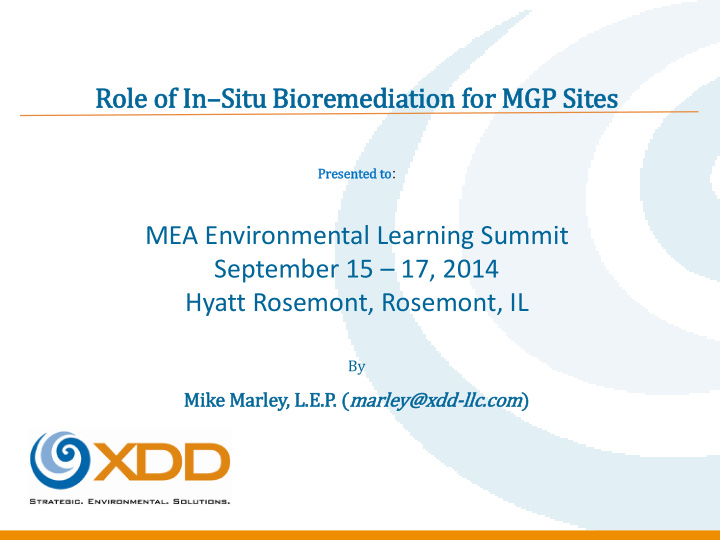



Role o e of I In–Si Situ B Bioremediation f n for MGP GP Sites Pres esen ented ed to to : MEA Environmental Learning Summit September 15 – 17, 2014 Hyatt Rosemont, Rosemont, IL By Mike M Marley, L L.E. E.P. ( marley@xdd-llc.com )
Benef Be efits o of Bi Biorem emed ediat ation • Because mo most contaminants biodegrade • Biodegradation can accelerate dissolution and reduce cleanup time – Rate is a function of availability • “True In-Situ” Remedy • Biodegradation in some form is commonly a component of a multi-technology site remedial strategy 2
Aerob obic vs. Ana naerobic D Degradatio tion (when you have a a c cho hoice) e) • Aerobic reactions are faster but the rate difference is not often significant; – Anaerobic rates can be increased with site condition enhancements; • Less Regulatory monitoring for aerobic pathways; • Solubility limits for oxygen delivery; – Can add much more nitrate and sulfate – higher solubility; • Should confirm site specific applicability with microcosm studies; – E.g. – native, mainly anaerobic, bacteria may not always degrade the contaminant of interest – In some cases, mainly chlorinated contaminants, it may be necessary to add bacteria (bioaugmentation) 3
Is s Biore remediation a appro ropri riate: G Goals s • Not Appropriate – Significant source mass reduction goal – High ring PAHs treatment (6-ring and above) • Due to low solubility • Appropriate – Limited source reduction or lighter end source materials – Plume control • Natural • Active – Chlorinated compounds – Access issues limit in-situ or excavation alternatives 4
Is Bioremediation a n app ppropr priate: e: G Geochemistry • Not Appropriate – No dissolved oxygen – if desire aerobic biodegradation • Add oxygen e.g. biosparging – pH : >8 or <6 • Unless buffer aquifer – No Dehalococcoides • Chlorinated compounds only • Need to bioaugment – Devoid of nutrients or trace minerals (not uncommon in high contaminant mass source areas) • Add nutrients / minerals 5
Bench Test, Pilot Testing, and Design More Than Just the Biology Characterization: Design: Pilot Testing: Full Scale: • Geology/target layers • Bench Test • Confirm injection and • Effective Design extraction rates • Accurate source impact • Modeling to achieve risk • = Results level assessment closure levels • Optimize full-scale grid • NAPL • Injection Strategy • Donor / Acceptor mass sufficient for contaminant mass Critical for Success 6
Pr Pre-Design / n / Lab T b Treatab ability Services • Treatability studies can minimize potential field failures – avoids incurring significant and unnecessary costs – benefits project schedule • Success or failure is a direct result of understanding – contaminant mass and its architecture (i.e. distribution in site specific geology) – impacts of the site geochemical and biological conditions on biodegradation potential e.g. • no DHC present in site soils (again for chlorinated compounds) • insufficient nutrients or inappropriate pH • unacceptable by-products – appropriate reagent formulations and dosages • Be careful designing based solely on previous successes or failures…..every site can be different 7
Plume C Cont ontainment – Na Natural • Natural biodegradation processes can control off- site migration of MGP plumes. • MNA analysis can be used to evaluate current conditions at the site and determine the effectiveness of natural containment. 8
Mann-Kendall A Analys ysis S Summary T ry Table • Off-site migration has been controlled though natural biodegradation processes. • Exceedences of VOC and PAH Preliminary Regulatory Guidelines (PRGs) are limited to the site. 9
Plume C Cont ontainment – Ac Active ve • Due to cost of source treatment, XDD is seeing more Utilities looking at plume containment using biodegradation – Predominantly dissolved components leaving source area – Bio-barriers can be cost effective alternative • Most we have seen are aerobic for PAHs and BTEX due to rapid degradation rates i.e. relatively short treatment zone 10
Summary • Biodegradation is often a component of site remedial / closure strategy and in some cases is used as a stand-alone approach • Need to understand site specific conditions and goals – Treatability studies whether in the laboratory (most common) or in the field provide key information for technology viability and design • In many cases the natural site bacteria just need tweaking of their environment, but in some cases you will need to add select bacteria to achieve the remedial goals • Appropriate use of the technology can reduce overall project costs and monitoring duration 11
Recommend
More recommend